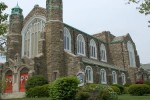Code Blue Used Locally To Help Homeless To A More Stable Path
Curley: To my knowledge no other community offers such a service, and even if they do, it is not to the extent of what Asbury Park offers
Winter Storm Grayson has passed but a deep freeze is expected to continue through Monday, according to forecasters. This will mean an ongoing effort to keep the homeless population among us safe.
In Asbury Park, a city known for its transient population, the over weeklong Code Blue designation continues to spark action by its local officials.
“There are efforts from us and there are efforts from the Police Department to motivate them to change,” the City’s Social Service Director Douglas Schultz said. “Each case is different.”
Put in place in May, the Code Blue legislation requires all 21 counties to develop a plan to help the homeless and medically fragile obtain shelter, food and clothing during sub freezing weather. In Monmouth County where no designated warming center exists, the emergent responsibility is most heavily passed on to Asbury Park where the homeless community knows it can seek shelter during off hours inside City Hall.
“To my knowledge no other community offers such a service, and even if they do, it is not to the extent of what Asbury Park offers,” said Monmouth County Freeholder John Curley. “In an emergency situation, when you are dealing with Mother Nature, it is done so well at the local level. I think it’s magnificent what is done here; by opening up City Hall and allowing the residents to come in.”
Curley, who serves as the Social Services liaison, said while plans to construct a homeless shelter at the shuttered Fort Monmouth stalled due to a road engineering hiccup, they are moving forward.
“Obviously there is a great demand,” he said. “The County does provide housing and there are a lot of diversified programs that we have.”
Still there is a shortfall – the Code Blue program has no attached funding support. Curley said there are approximately eight homeless shelters available to men and women across Monmouth County. Because of the lack of funding, the County choses to partner with outside agencies to provide ‘a better balance of services.’
“You have to realize, our funding is pass through funding,” Curley said. “It comes from the federal and state, and then, when tax dollars are available.”
In the meantime, the homeless from across the County continue to congregate in Asbury Park, a community that administers a host of programs to address their needs; be it food pantries, soup kitchens, or overnight shelter, found at the Memorial Drive Jersey Shore Mission, the recently launched Women’s Hospitality Network – a rotation of churches that offer overnight stays and inside the City Hall lobby.
Deputy Chief David Kelso, who heads the 90-member police department, said a majority of those who seek shelter locally are not Asbury Park residents.
“We’ve been providing a warm place to stay as far back as I can remember,” he said. We have had people come and stay from as far as the Keansburg/Union Beach area.”
Kelso said his officers seek to reach the homeless population in areas they are known to frequent in order to help them get the needed assistance.
But over the past week, City officials have used the Code Blue designation as an opportunity to not only help place the homeless population in temporary shelters but to assist them in establishing a game plan to become more productive members of society.
“We individually try to case manage people,” Schultz said. “We meet with someone, find out what their resources are, what they can do, what they are able to access, and we try to facilitate getting them to something.”
Prior to the Code Blue designation, an average of 23 people a night sought refuge in the city hall lobby, Schultz said. This week, that number dropped to an average of 12, with only three people hailing from Asbury Park. Today, 10 of those people have been placed through the County’s aid.
Schultz, who has distributed free bus tickets so that an individual can make it to the County resource, said his hands are tied by limited funding.
According to the legislation, the County is in charge of the Code Blue program but any town, like Asbury Park, that has a documented count of over 10 homeless people becomes a part of the planning process.
In Monmouth County there are 66 documented homeless people, with 16 of them in Asbury Park. Neighboring Neptune Township has a documented figure of four homeless, OEM Coordinator Michael Bascom said.
“We believe there is more than that because we have encountered more than that” he said.
And even though, they are not required by Code Blue guidelines to adopt a plan, the Township did so, Bascom said.
Like Asbury Park, the Neptune police officers and other emergency service personnel seek out locations where the homeless population is known to frequent in order to provide assistance. When weather like the recent below freezing temperatures prove dangerous to the homeless community, the township opens its Senior Center and Library as a warming center, Bascom said.
“We will allow access after hours, direct them to the County Social Services, or known facilities like the Jersey Shore Rescue Mission,” he said. “We do seek them out to let them know what their options are.”
Still, the long running open door policy in Asbury Park is rare, possibly because it’s so well known throughout the homeless community.
But the open door policy is not without its challenges. To keep disorderly conduct at bay, Kelso said the department’s watch commander, or an overnight on duty officer, makes routine checks.
The recently launched Women’s Hospitality Network, a program administered through the collaboration of local churches, houses homeless women on a rotating basis. Founding member Derek Minno Bloom said they have been averaging four to six women a night.
“During the Code Blue it was low,” he said. “The ladies’ families took them in for a few days during the snowstorm.”
The Network not only offers women a place to sleep but serves them a warm a meal and provides an onsite social worker to help them forge a path to stability.
Aside from serving a hot meal at 6 p.m. daily, the Jersey Shore Rescue Mission offers shelter and its Life Change program, a faith based work therapy program administered in association with anonymous drug and alcohol support groups.
Still, what is most needed is a stable shelter like the one proposed at Fort Monmouth, local officials said.
“The County really needs a shelter,” Schultz said.
“That would allow people to stay for a short period of time,” Kelso added.
The proposed Fort Monmouth Shelter is expected to come online by next summer’s end, according to County officials. It replaces the shelter damaged during Superstorm Sandy, and will relieve the constraints at the temporary shelter being housed at the John L. Montgomery Care Center in Freehold.
——————————————————————————————————
Follow the Asbury Park Sun on Facebook, Twitter and Instagram.
The Asbury Park Sun is affiliated with the triCityNews newspaper.













